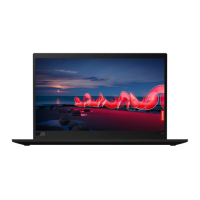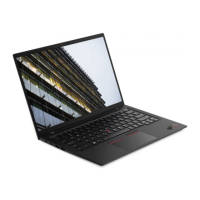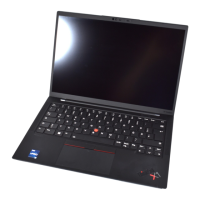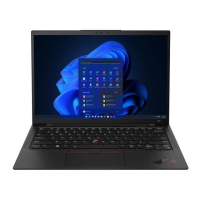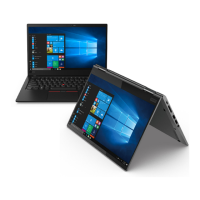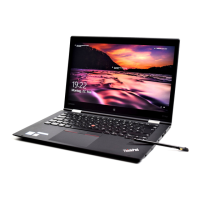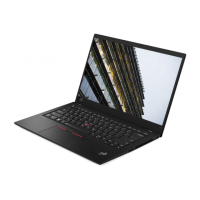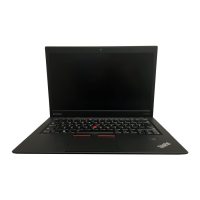












Do you have a question about the Lenovo ThinkPad X1 Carbon and is the answer not in the manual?
Provides crucial safety guidelines for using the notebook computer and its components.
Details conditions that indicate potential safety issues or product damage, requiring immediate action.
Information on self-servicing, approved service providers, and customer replaceable units (CRUs).
Guidelines for safe use, handling, and connection of power cords and adapters.
Ensures extension cords, surge protectors, and power strips are rated correctly.
Instructions on using electrical outlets and plugs safely, avoiding overload.
Warnings about hazardous voltage inside power supplies and not servicing them.
Cautionary advice on connecting/disconnecting external device cables while the computer is on.
Safety precautions and handling instructions for batteries to avoid injury or damage.
Instructions for handling built-in batteries and authorized repair facilities.
Warnings about explosion risk if coin-cell battery is replaced incorrectly.
Precautions for managing heat generated by the computer and ensuring proper ventilation.
Safety instructions to avoid shock hazards from electric current and cables.
Caution regarding handling the LCD to prevent breakage and exposure to internal fluid.
Guidance on safe volume levels for headphones to protect hearing.
Includes plastic bag and glass parts notices to ensure user safety.
Introduces computer hardware features, locating controls, connectors, and indicators.
Identifies components visible from the front of the ThinkPad X1 Carbon.
Identifies connectors and slots on the right side of the ThinkPad.
Details connectors on the left side, including power and docking ports.
Shows fan louvers, speakers, and the emergency-reset hole on the computer's bottom.
Identifies fan louvers, MicroSD card slot, and Micro-SIM card slot at the rear.
Explains the meaning of system-status indicators on the ThinkPad logo and power button.
Guides on finding machine type, model, FCC ID, and other important labels.
Details how machine type and model information aids in service and support.
Information on FCC and IC certification labels found on the computer base cover.
Describes Certificate of Authenticity labels for Windows 7 and Genuine Microsoft labels for Windows 10.
Lists key hardware features like microprocessor, memory, storage, display, and keyboard.
Provides specifications on size, heat output, power source, and operating environment.
Details temperature and humidity ranges for computer operation and storage.
Introduces preinstalled Lenovo programs that enhance computer usability and security.
Explains the benefits of registering your computer and how to do it.
Provides tips for optimizing computer use and common usage questions.
Instructions and gestures for using the multi-touch screen on ThinkPad X1 Yoga.
Details how to use the ThinkPad Pen Pro for precise input and sketching.
Explains different modes like Notebook, Stand, Tablet, and Tent for flexible use.
Instructions on how to rotate the display of the ThinkPad X1 Yoga computer.
Describes using the computer in notebook mode for document editing and email.
Details using the computer in stand mode for viewing photos and videos.
Explains using the computer in tablet mode for web browsing and interaction.
Describes using the computer in tent mode for presentations and viewing photos.
Information about the keyboard's frame travel function and behavior in different modes.
Steps to customize keyboard settings for extended functions via Control Panel.
Explains the Windows key, function keys, and key combinations for special functions.
Details the TrackPoint pointing device and trackpad for navigation and gestures.
Explains the components and operation of the TrackPoint pointing stick.
Instructions for using the trackpad for pointing, clicking, and scrolling.
Describes touch gestures for trackpad interaction, including Windows 10 gestures.
How to customize pointing device settings, including touch gestures, in Control Panel.
Instructions on how to replace the removable cap on the TrackPoint pointing stick.
Guidance on managing battery power and conserving energy for extended use.
Connecting the computer to AC power for operation and battery charging.
How to check the battery charge level and remaining usage time.
Steps to enable the battery alarm for low battery notifications in Windows 7.
Instructions on how to charge the battery and expected charging times.
Tips to maximize the lifespan and performance of the computer's battery.
How to adjust power plan settings for optimal balance between performance and saving.
Introduces modes like Sleep and Hibernation to conserve power.
Safety guidelines and warnings for handling and replacing the battery pack.
Information on connecting to networks via Ethernet and wireless connections.
How to connect to a local network or broadband using Ethernet adapters or docks.
Details on establishing and checking wireless-LAN and wireless-WAN connections.
Steps to establish a wireless-LAN connection and tips for best connection.
How to check wireless-LAN connection status using icons and gauges.
Information on establishing wireless-WAN connections via cellular networks.
Steps to enable and use Bluetooth for connecting devices and transferring data.
Instructions for pairing computers with NFC cards or smartphones.
How to connect an external display, choose display modes, and change settings.
Steps for connecting an external monitor using cables via VGA, Mini DisplayPort, or HDMI.
How to connect a wireless display using Wi-Di or Miracast features.
Explains display modes like Duplicate, Extend, and Projector only.
How to change resolution, orientation, and other display settings.
Details built-in microphones, speakers, and audio connectors for multimedia.
Instructions for using the integrated camera for photos, video, and conferencing.
How to adjust camera settings for desired video output quality.
Instructions for installing, removing, and using microSD cards for storage.
Precautions to avoid static-electricity damage when handling computer components.
Steps to disable the internal battery for servicing the computer.
Instructions for installing or replacing the micro SIM card for wireless-WAN connections.
Step-by-step guide to removing and reinstalling the computer's base cover.
Procedure for replacing the M.2 solid-state drive, emphasizing careful handling.
Instructions for installing or replacing the wireless-WAN card.
Procedure for replacing the coin-cell battery, with safety warnings.
Steps to replace the computer's internal speakers.
Importance of ergonomics and healthy habits for comfort and performance.
Tips on posture, display positioning, and chair use for comfortable computing.
Provides travel tips, including airport security and airplane usage advice.
General tips for traveling confidently and efficiently with your computer.
Advice for using computers on airplanes, including wireless restrictions.
A checklist of items to consider packing when traveling with your computer.
Lists keyboard shortcuts for accessing features like Ease of Access Center.
Tools for configuring computer settings to suit physical and cognitive needs.
Enables controlling the computer by voice for tasks like starting programs or dictating text.
How to adjust screen resolution to make text and images easier to read.
Adjusting item size temporarily or permanently for better readability.
Preventing unauthorized use by setting power-on, supervisor, and hard disk passwords.
Icons indicating where to type power-on, supervisor, or hard disk passwords.
Setting a power-on password to protect computer access by unauthorized users.
Protects system information in ThinkPad Setup, controlling configuration changes.
Setting user and master hard disk passwords to protect solid-state drive information.
Procedure for setting user or user+master hard disk passwords.
Steps to change or remove user and master hard disk passwords.
Recommendations for password length, safe storage, and security features.
Tips to maximize security for internal solid-state drives against attacks.
Using BitLocker to protect the operating system and data from unauthorized access.
Hardware encryption feature for protecting against security attacks on media.
Configuring the embedded security chip for data protection and access control.
Enabling fingerprint authentication to replace passwords for secure login.
Recommended steps for enrolling multiple fingerprints for authentication.
Proper technique for scanning your finger on the fingerprint reader.
Explains the indicator lights for fingerprint reader status (off, solid green, amber).
How to link fingerprints with power-on and hard disk passwords for unified login.
Adjusting fingerprint reader settings in the program or ThinkPad Setup.
Tips for cleaning and preventing damage to the fingerprint reader.
Methods and importance of securely deleting data before disposing of the computer.
How a firewall program protects against internet security threats and privacy.
Instructions for installing a new operating system, including Windows 7 and Windows 10.
Detailed steps for installing the Windows 7 operating system, including driver installation.
Steps for installing the Windows 10 operating system and post-installation tasks.
How to download and install device drivers from the Lenovo Web site.
Instructions for configuring BIOS settings using the ThinkPad Setup program.
Lists items found in the Main menu of the ThinkPad Setup program.
Details menu items within the Config tab for system configuration.
How to change the date or time settings in the ThinkPad Setup menu.
Options for setting supervisor password, BIOS lock, and boot device security.
Settings for boot devices, UEFI/Legacy boot, and boot mode.
Options for exiting ThinkPad Setup, saving changes, or loading defaults.
Instructions on how to update the UEFI BIOS using optical discs or Windows programs.
Information on manageability features for remote operation of client computers.
Configuring Wake on LAN, Network Boot sequence, and Flash update features.
Tips for maintaining computer health, including checking drive capacity and backing up data.
Importance of updating device drivers for optimal performance and issue resolution.
Steps to download and install updated device drivers from the Lenovo website.
Using the System Update program to download and install software packages.
Guidelines for proper handling, cleaning, and storage to maintain the computer.
Precautions regarding magnets, temperatures, and electrostatic discharge.
Tips on avoiding pressure on the display and proper hinge usage.
Instructions for safely moving the computer, including disconnecting devices.
Proper procedures for installing, replacing, and storing storage devices.
Steps for cleaning the computer cover using a mild detergent solution.
Procedure for cleaning the keyboard using isopropyl rubbing alcohol and a soft cloth.
Instructions for gently cleaning the computer display screen with a dry cloth.
Using Lenovo Solution Center for troubleshooting and finding diagnostic information.
General guide for solving computer errors indicated by messages or beep codes.
Steps to resolve issues when the computer becomes completely unresponsive.
Immediate actions to take if liquid is spilled on the keyboard to prevent damage.
Lists common error messages and their solutions for hardware and system issues.
Interpreting beep error patterns to identify hardware problems like memory or video issues.
Steps to check memory modules for operation issues, including error messages.
Troubleshooting common Ethernet and wireless-LAN connection issues.
Solutions for Ethernet connection failures, driver issues, and speed problems.
Steps to resolve issues connecting to a network using the built-in wireless card.
Troubleshooting unauthorized WAN card messages and connection problems.
Solutions for sound not coming from Bluetooth headsets or PIM item reception issues.
Common problems with keyboards, TrackPoint, and trackpads, and their solutions.
Addressing pointer drift or the pointing device/trackpad not working.
Solutions for keys not working, including external numeric keypad issues.
Troubleshooting computer display, external monitor, and audio device problems.
Resolving issues like blank screens, unreadable displays, or distorted images.
Solutions for blank external monitors, incorrect resolution, or wrong characters.
Resolving issues with sound playback, microphone input, and volume controls.
Solutions for fingerprint reader issues like dirt, stains, or authentication failures.
Troubleshooting battery charging, operating time, and power issues.
Resolving battery not charging, short operating time, or computer not powering on.
Diagnosing issues where the AC adapter icon is not displayed or indicator lights are off.
Steps to check for no power or battery power issues, including connections and adapters.
Resolving issues where the system does not respond or turn off.
Action for corrective measures when error messages appear before OS loads.
Resolving issues like unexpected sleep mode or blank display after sleep.
Solutions for slow file read/write processes on solid-state drives.
Troubleshooting applications that do not run correctly due to memory or driver issues.
Common issues with USB connectors and other ports, and how to resolve them.
Resolving issues when a USB connected device does not work.
Solutions for the ThinkPad Pen Pro not performing well.
Troubleshooting computer startup or resume issues related to the ThinkPad OneLink Dock.
Information on recovery solutions and backup software for Windows 7.
Steps to create and use recovery media (discs or USB drives) for restoring the computer.
Using Rescue and Recovery to back up and restore system contents and files.
Steps to perform a backup using the Rescue and Recovery program.
Steps to perform a recovery operation using the Rescue and Recovery program.
Performing recovery operations independently from the Windows OS.
How to reinstall factory-installed programs and device drivers.
Solutions for accessing Rescue and Recovery workspace or Windows environment.
Information on resetting the computer or using advanced startup options.
Steps to reset the computer, choose to keep or remove files, and reinstall Windows.
Using advanced options to change firmware, startup settings, or restore from image.
How to use Windows recovery environment for OS recovery when it fails to start.
Steps to create and use a recovery USB drive for troubleshooting and fixing problems.
Precautions to avoid static-electricity damage when handling computer components.
Steps to disable the internal battery for servicing the computer.
Instructions for installing or replacing the micro SIM card for wireless-WAN connections.
Step-by-step guide to removing and reinstalling the computer's base cover.
Procedure for replacing the M.2 solid-state drive, emphasizing careful handling.
Instructions for installing or replacing the wireless-WAN card.
Procedure for replacing the coin-cell battery, with safety warnings.
Steps to replace the computer's internal speakers.
Information and steps to prepare before contacting Lenovo for help.
Explains the benefits of registering your computer and how to do it.
How to download updated software to resolve computer problems.
Collecting problem symptoms, details, and system information before calling for help.
Resources for technical assistance, hardware repair, and service options from Lenovo.
Using diagnostic programs to identify hardware problems and check for driver updates.
Accessing drivers, software, manuals, and FAQs on the Lenovo support website.
Information on services available during the warranty period and what to prepare.
Information on purchasing extended support, repair services, and custom installations.
How to access the Lenovo Limited Warranty documentation for Ubuntu systems.
How to access the Ubuntu help system for operating system information.
Contacting providers for Ubuntu OS and application support, and Lenovo for hardware.
Information on wireless-LAN and Bluetooth interoperability and supported profiles.
Compliance statements for wireless communications in Brazil and Mexico.
Where to find wireless regulatory notices, including on the Lenovo website.
Product name, compliance ID, and machine types for ThinkPad models.
Information on the US Export Administration Regulations (EAR) classification.
FCC Declaration of Conformity, Industry Canada statement, and EU EMC Directive compliance.
Regulations and user responsibilities for recycling electrical and electronic equipment (WEEE).
Information and link for recycling Lenovo products in China.
Guidelines for collecting and recycling Lenovo computers in Japan.
Proper disposal methods for components containing heavy metals in Japan.
Instructions for disposing of disused lithium batteries, complying with local regulations.
Guidelines for company employees and home users on battery pack disposal.
Brazilian regulations for disposing of electrical and electronic equipment.
Battery recycling information for Taiwan, with recycling symbol.
EU Directive 2006/66/EC on batteries and accumulators, collection and recycling.
Battery recycling information for the United States and Canada.
Product compliance with EU Directive 2011/65/EU on hazardous substances.
Product compliance with Turkey's directive on hazardous substances in electrical equipment.
RoHS compliance information for Ukraine.
RoHS compliance as per India's E-Waste (Management & Handling) Rules, 2011.
RoHS compliance information for China, detailing hazardous substance content in parts.
Information about the ENERGY STAR program for energy-efficient products.
Preset power management features like display turn-off and sleep mode timings.
Lists trademarks of Lenovo, Intel, Apple, Microsoft, and VESA.



